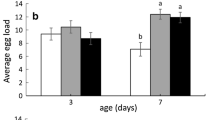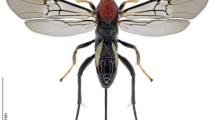Abstract
The parasitoidChelonus sp. nearcurvimaculatus Cameron showed higher survival rates when reared on the pink bollworm,Pectinophora gossypiella (Saunders) than the potato tuberworm,Phthorimaea operculella (Zeller), demonstrating a developmental host preference for the former. Females reared for one generation on the source host,Pectinophora, demonstrated a higher reproductivity on another, the factitious host,Phthorimaea, than when reared for 30 generations on the latter. An additional expression of suitability ofPectinophora forChelonus sp. was a greater female progeny production. ConditioningChelonus sp. to attackPhthorimaea more effectively by rearing the parasitoid on that host failed, but succeeded by passage through the source host,Pectinophora. The importance of categorizing the degree of host specificity of different parasitoid species prior to mass rearing and field release is discussed.
Résumé
Le parasitoïdeChelonus sp. près decurvimaculatus,Cameron a montré des taux de survie plus élevés quand il est élevé surPectinophora gossypiella (Saunders) que surPhthorimaea operculella (Zeller), démontrant une préférence d'hôte pour le premier, dans lequel il se développe le mieux. Les femelles, élevées pendant une génération sur l'hôtePectinophora, ont fait preuve d'une reproduction plus importante sur un autre hôte, de substitution,Phthorimaea, que quand elles sont élevées pendant 30 générations sur ce dernier. Une autre expression de l'aptitude dePectinophora pourChelonus sp. est une plus grande production de descendants femelles. On n'a pas réussi à conditionnerChelonus sp. pour parasiterPhthorimaea plus efficacement en élevant le parasitoïde sur cet hôte, mais on a réussi par passage chez l'hôte d'originePectinophora. On discute l'importance de classer les espèces de parasitoïdes selon leur degré de spécifité pour l'hôte avant l'élevage en masse et la libération dans la nature.
Similar content being viewed by others
References
Abbott, W.S. — 1925. A method of computing the effectiveness of an insecticide. —J. Econ. Entomol., 18, 265–267.
Adkisson, P.L., Vanderzant, E.S., Bull, D.L. &Allison, W.E., — 1960. A wheat germ medium for rearing the pink bollworm. —J. Econ. Entomol., 53, 759–762.
Arthur, A.P. — 1965. Absence of preimaginal conditioning inItoplectis conquisitor (Say) [Hymenoptera: Ichneumonidae]. —Can. Entomol., 97, 1000–1001.
Bartlett, M.S. — 1947. The use of transformations. —Biometrics, 3, 39–52.
Birch, L.C. — 1948. The intrinsic rate of natural increase of an insect population. —J. Anim. Ecol., 17, 15–26.
Hopkins, A.D. — 1916. Economic investigation of the scolytid bark and timber beetles of North America. — U.S. Dept. of Agric. Program of Work, 1917, 353 pp.
Kajita, H. — 1973. Rearing ofApanteles chilonis on the rice stem borer,Chilo suppressalis. —Jap. J. Appl. Entomol. Zool., 17, 5–9.
Legner, E.F. — Observations on hybridization and heterosis in parasitoids of synanthropic flies. —Ann. Entomol. Soc. Am., 65, 254–263.
—, — 1976. Low storage temperature effects on the reproductive potential of three parasitoids ofMusca domestica L. —Ann. Entomol. Soc. Am., 69, 435–441.
Legner, E.F. &Gerling, D. — 1967. Host-feeding and oviposition onMusca domestica bySpalangia cameroni, Nasonia vitripennis, andMuscidifurax raptor [Hymenoptera: Pteromalidae] influence their longevity and fecundity. —Ann. Entomol. Soc. Am., 60, 678–691.
Lewis, W.J., Sparks, A.N. &Redlinger, L.M. — 1971. Moth odor: a method of host-finding byTrichogramma evanescens. —J. Econ. Entomol., 64, 557–558.
Markwick, N.D. — 1974. A comparative study of four housefly parasites [Hymenoptera: Chalcidoidea]. —Ph. D. Thesis, Univ. of Wellington, Victoria, New Zealand 333 pp.
Marston, N. &Ertle, L.R. — 1973. Host influence on the bionomics ofTrichogramma minutum. —Ann. Entomol. Soc. Am., 66, 1155–1162.
Smilowitz, Z. — 1974. Relationships between the parasitoidHyposoter exiguae and cabbage looper,Trichoplusia ni: evidence for endocrine involvement in successful parasitism. —Ann. Entomol. Soc. Am., 67, 317–320.
Steel, G.D. &Torrie, J.H. — 1960. Principles and Procedures of Statistics, With Special Reference to the Biological Sciences. —McGraw-Hill Book Co., Inc. New York, 481 pp.
Taylor, T.A. & Stern, V.M. — Host-preference studies with the egg parasiteTrichogramma semifumatum [Hymenoptera: Trichogrammatidae]. —Ann. Entomol. Soc. Am., 64, 1381–1390.
Thompson, S.N. — 1974. The fatty acid composition of parasitic Hymenoptera and possible biological significance. —Ann. Entomol. Soc. Am., 67, 627–632.
Zilsparne, A. — 1968. Use of some host insects to increaseTrichogramma effectiveness. —Akad. Latvijas Padomju SSR. Vestis, 7, 91–95.
Author information
Authors and Affiliations
Additional information
Research supported by appropriation of the State of California, Department of Food and Agriculture, Agreement No. 9114.
Rights and permissions
About this article
Cite this article
Legner, E.F., Thompson, S.N. Effects of the parental host on host selection, reproductive potential, survival and fecundity of the egg-larval parasitoid,Chelonus sp. Nearcurvimaculatus, reared onPectinophora gossypiella andPhthorimaea operculella . Entomophaga 22, 75–84 (1977). https://doi.org/10.1007/BF02372992
Issue Date:
DOI: https://doi.org/10.1007/BF02372992




